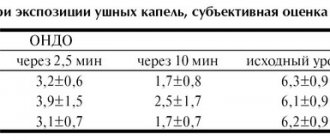Pharmacodynamics
Framycetin sulfate is an antibiotic from the group of aminoglycosides and has a bactericidal effect. It has a wide spectrum of antibacterial action, is active against gram-positive microorganisms, including Staphylococcus aureus, and most clinically significant gram-negative microorganisms (Escherichia coli, dysentery bacillus, Proteus, etc.). Ineffective against streptococci. Does not affect pathogenic fungi, viruses, anaerobic flora. Resistance of microorganisms to framycetin sulfate develops slowly.
Gramicidin has a bactericidal and bacteriostatic effect, expanding the spectrum of antimicrobial action of framycetin due to its activity against streptococci and anaerobic microorganisms. Enhances the effects of framycetin against staphylococci, because also has an antistaphylococcal effect.
Dexamethasone is a corticosteroid that has a pronounced anti-inflammatory, antiallergic and desensitizing effect.
Dexamethasone suppresses inflammatory processes by inhibiting the release of inflammatory mediators, the migration of mast cells and reducing capillary permeability.
When instilled into the eyes, it reduces pain, burning, lacrimation, and photophobia. When instilled into the ears, it reduces the symptoms of otitis externa (redness of the skin, pain, itching, burning in the external auditory canal, feeling of ear congestion).
Sofradex eye and ear drops 5 ml
Tradename
Sofradex
Dosage form
Eye/ear drops
Compound
1 ml of solution contains framycetin sulfate - 5 mg gramicidin - 0.05 mg dexamethasone (in the form of sodium metasulfobenzoate) - 0.5 mg, excipients: lithium chloride, sodium citrate, citric acid monohydrate, phenylethyl alcohol, ethanol, polysorbate 80, water for injection.
Description
Transparent, almost colorless solution with a characteristic odor of phenylethyl alcohol
Pharmacotherapeutic group
Combination drugs, corticosteroids and anti-infectives.
Pharmacological properties
Framycetin sulfate is an antibiotic from the group of aminoglycosides that acts bactericidal, disrupting protein synthesis in the microbial cell. It has a wide spectrum of antibacterial action, is active against gram-positive (staphylococci, pneumococci and others) and gram-negative microorganisms (Escherichia coli, dysentery bacillus, Proteus and others). Little effective against streptococci. Does not affect pathogenic fungi, viruses, anaerobic flora. Resistance of microorganisms to framycetin sulfate develops slowly. Gramicidin - has a bactericidal and bacteriostatic effect, is active against streptococci, staphylococci, causative agents of anaerobic infection and other microorganisms. Dexamethasone is a glucocorticosteroid and does not have mineralocorticoid activity. Practically does not cause sodium and water retention in the body. It has a pronounced anti-inflammatory, antiallergic and desensitizing effect. Dexamethasone actively suppresses inflammatory processes, inhibiting the release of inflammatory mediators, the migration of mast cells and reducing capillary permeability. When instilled into the eyes, it reduces pain, burning, lacrimation, and photophobia.
Indications for use
Bacterial diseases of the anterior segment of the eye - blepharitis, conjunctivitis, keratitis (without damage to the epithelium), iridocyclitis, scleritis, episcleritis, infected eczema of the eyelid skin, otitis externa
Directions for use and doses
For eye diseases: for mild infections, 1-2 drops of the drug are instilled into the conjunctival sac every 4 hours. In the event of a severe infectious process, the drug is instilled every hour. As inflammation decreases, the frequency of drug instillations decreases. Do not touch the tip of the pipette to your eye. For ear diseases: 2-3 drops 3-4 times a day. The duration of use of the drug should not exceed 7 days, except in cases of obvious positive dynamics of the disease (glucocorticoid can mask hidden infections, and long-term use of antimicrobial components of the drug contributes to the emergence of resistant flora).
Side effects
Often: irritation, burning, pain, itching, dermatitis, increased intraocular pressure (presence of dexamethasone), formation of subcapsular cataracts and thinning of the cornea (in diseases of the cornea or sclera, accompanied by a decrease in the thickness of these membranes of the eye) with long-term (more than 1 month) instillation of the drug into conjunctival sac Possible: the development of a secondary infection, which is observed after the use of combined drugs containing glucocorticosteroids and antibacterial agents, fungal infections of the cornea (more often with long-term use), which may be evidenced by the appearance of non-healing ulcers on the cornea after prolonged treatment with steroid drugs.
Contraindications
Viral (including herpetic) or fungal infections of the eyes and ears, ocular tuberculosis, trachoma, hypersensitivity to any of the components of the drug, post-traumatic or post-inflammatory perforation of the eardrum (risk of ototoxicity), pregnancy and lactation, disruption of the integrity of the corneal epithelium and thinning of the sclera ( possible perforation of the eye shell). Drug interactions Framycetin sulfate should not be used together with other antibiotics that have ototoxic and nephrotoxic effects (streptomycin, monomycin, kanamycin, gentamicin). Special instructions Extreme caution should be exercised when prescribing the drug to infants and young children. Long-term use in high doses in children may lead to suppression of adrenal function.
Warning
Do not use for eye injections! A repeated course of treatment with the drug is carried out on the recommendation of a doctor. It should be taken into account that framycetin sulfate, which is part of the drug, is an antibiotic from the group of aminoglycosides, which are characterized by nephro- and ototoxicity, especially when used in large doses and in patients with renal or liver failure. During treatment, it is recommended to monitor intraocular pressure. Effect on the ability to drive vehicles or potentially dangerous mechanisms When instilled into the eye, blurred vision is possible, which must be taken into account when working with mechanisms and driving a car.
Overdose
Symptoms - increased severity of side effects. Long-term local treatment in large doses can have a general systemic effect on the body. Treatment is symptomatic.
Release form and packaging
Eye/ear drops in 5 ml bottles. 1 bottle along with instructions for use in a cardboard box.
Storage conditions
Store at a temperature not exceeding +25? C. Keep out of the reach of children!
Best before date
2 years Shelf life after opening the bottle is 1 month. Do not use after the expiration date indicated on the package!
Conditions for dispensing from pharmacies
On prescription
Manufacturer
AventisPharmaLtd / Aventis Pharma Ltd., India
Contraindications
increased individual sensitivity to any of the components of the drug;
viral or fungal infections, tuberculosis, purulent inflammation of the eyes, trachoma;
violation of the integrity of the corneal epithelium and thinning of the sclera;
herpetic keratitis (tree-like corneal ulcer) (possible increase in the size of the ulcer and significant deterioration of vision);
glaucoma;
perforation of the eardrum (penetration of the drug into the middle ear can lead to the development of ototoxicity);
pregnancy;
breastfeeding period;
infants.
With caution: young children (especially when prescribing the drug in large doses and for a long time - there is a risk of developing systemic effects and suppressing adrenal function).
Analogues of Sofradex
Level 4 ATC code matches:
Dexa-Gentamicin
Garazon
Maxitrol
Tobradex
There are analogues that differ in the list of active substances:
- Eye/ear drops Dexona (absent - gramicidin );
- Eye/ear drops Jenodex (only dexamethasone , additional active compounds are polymyxin B , chloramphenicol );
- Eye/ear drops Combinil Duo (only dexamethasone , the additional active substance is ciprofloxacin ).
Side effects
Allergic reactions are usually of a delayed type, manifested by irritation, burning, pain, itching, and dermatitis.
With long-term use of local GCS it is possible:
- an increase in IOP with the development of the glaucoma symptom complex (damage to the optic nerve, decreased visual acuity and the appearance of visual field defects), therefore, when using drugs containing GCS for more than 7 days, IOP should be measured regularly;
- development of posterior subcapsular cataract (especially with frequent instillation);
- thinning of the cornea or sclera, which can lead to perforation;
- addition of a secondary (fungal) infection.
Sofradex price, where to buy
Medical portals offer the best options on where to find Sofradex eye and ear drops, the price of which will be the most affordable. The price in Ukraine ranges from 30-43 UAH; in the Russian Federation you can buy the drug for about 310 rubles.
- Online pharmacies in RussiaRussia
- Online pharmacies in KazakhstanKazakhstan
ZdravCity
- Sofradex eye and ear drops.
5 ml (complete with dropper) Gland Pharma Limited/Sovereign Pharma Private Limited RUB 330 order
Pharmacy Dialogue
- Sofradex bottle 5mlSanofi Aventis
RUB 309 order
- Sofradex (5ml bottle)Aventis Pharma
RUB 341 order
show more
Directions for use and doses
Eye diseases: in case of a mild infection, 1-2 drops of the drug are instilled into the conjunctival sac of the eye every 4 hours. In the case of a severe infection, the drug is instilled every hour. As inflammation decreases, the frequency of drug instillations decreases.
Ear diseases: instill 2-3 drops 3-4 times a day; a gauze swab moistened with a solution can be placed in the external auditory canal.
The duration of use of the drug should not exceed 7 days, except in cases of obvious positive dynamics of the disease (GCS can mask hidden infections, and long-term use of the antimicrobial components of the drug can contribute to the development of resistant flora).
Indications for use
Sofradex eye drops are usually prescribed for superficial bacterial eye infections with an inflammatory or allergic component, as well as for blepharitis , infected eyelid eczema , stye , allergic conjunctivitis , rosacea keratitis , scleritis , episcleritis , iridocyclitis , iritis .
Ear drops appear to be effective for acute or chronic otitis externa .
special instructions
With long-term use of the drug, as with long-term use of other antimicrobial agents, the development of superinfections caused by drug-resistant microorganisms, including fungi, is possible.
Long-term instillation of the drug into the eyes can lead to thinning of the cornea with the development of its perforation, as well as to an increase in IOP. Treatment with drugs containing corticosteroids should not be repeated or prolonged without regular monitoring of IOP and eye examination for the development of cataracts or secondary infections.
Local corticosteroids should never be used in patients with ocular hyperemia of unknown etiology, because inappropriate use of the drug can lead to significant deterioration of vision (see “Contraindications”).
Framycetin sulfate, which is part of the drug, is an antibiotic from the group of aminoglycosides, which are characterized by the development of nephro- and ototoxic effects when used systemically or topically on open wounds or damaged skin. These effects are dose dependent and increase with renal or hepatic impairment. Although the development of these effects was not observed when the drug was instilled into the eyes, the possibility of their occurrence should be taken into account in the case of topical use of high doses of the drug in children.
The duration of use of the drug should not exceed 7 days, except in cases of obvious positive dynamics of the disease, because long-term use of GCS, which is part of it, can mask hidden infections, and long-term use of antimicrobial components can contribute to the emergence of resistant microflora.
The bottle must be closed after each use. Do not touch the tip of the pipette to your eye. After opening the bottle, the drug should be used within 1 month.
Patients who temporarily lose clarity of vision after instilling the drug into the eye are not recommended to drive a car or work with complex machinery, machines or any other complex equipment that requires clear vision immediately after instilling the drug.



